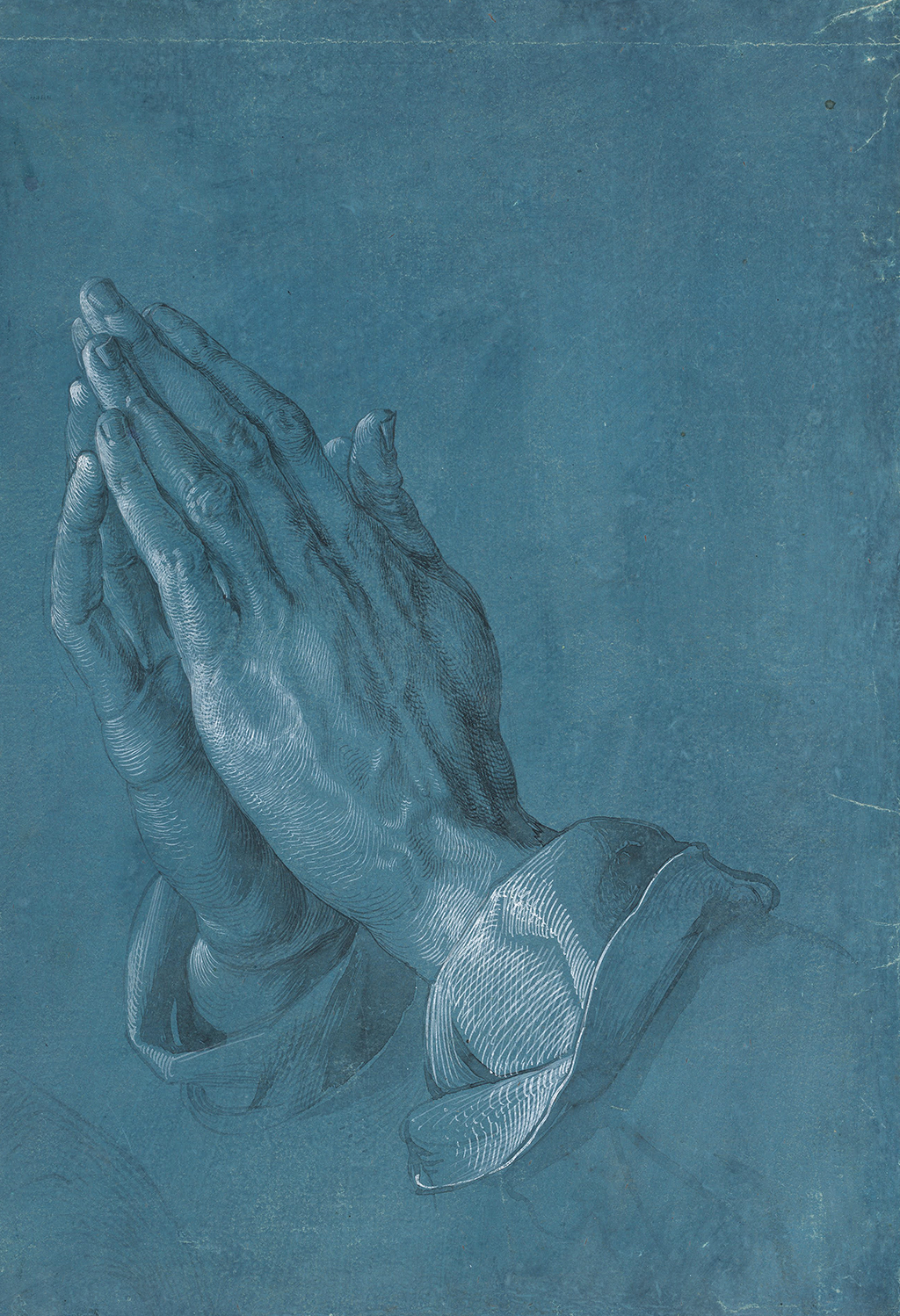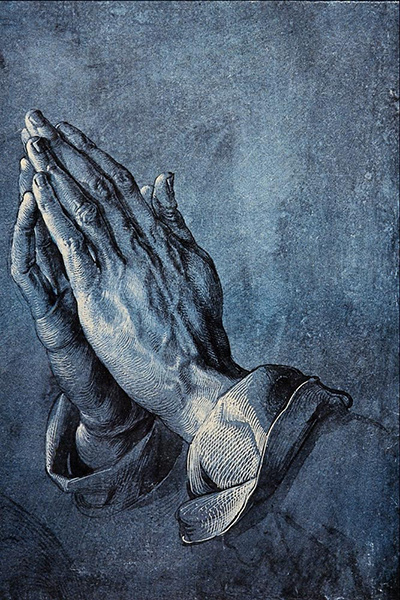In the early 16th century, Albrecht Dürer created the pen and ink drawing we know of as Praying Hands, or Betende Hände in German.
The drawing is on blue paper that Dürer made himself. It was believed for many centuries to have been a preparatory drawing for part of an altarpiece known as the Heller Altar that was a commission by Jakob Heller.
It was while in his twenties that Dürer was able to establish a reputation and influence across Europe. This was down to the beautiful woodcut prints he produced. Of the artists that were to follow him, Dürer was an inspiration to many, especially when it comes to printmaking.
His career was to last over 40 years, and during this time, Dürer went on to produce a large number of works. This also includes engravings for which he is best known. One of the many well-known works credited to Albrecht Dürer is Praying Hands, an ink and pencil drawing produced in 1508.
The drawing is one of a number of sketches that Dürer produced as preparation for an altarpiece, or so was originally believed.
Known as the Leonardo of the North, Albrecht Dürer was a renowned artist of the German Northern Renaissance movement. Born in Nuremberg in 1471 he was a painter, printmaker and theorist.
The sketch that we find here shows the hand of an apostle and was destined to form the centre panel of the three-panel altarpiece. The drawing depicts the hands of a man who is praying. You do not see the man's body in the picture.
What you do see however are the folded sleeves of the man. The image of the hands appear in several of Dürer's other works. When it comes to the model for the sketch, there are many stories. One story is that Dürer made use of his brother's hands for the sketch. However, there is proof that the story is true.
When it comes German Renaissance artists, Dürer is one of the leading figures of the time. His legacy is that not only is he recognised for his engravings, he is also thought of as one of Europe's first watercolour landscape artists. Of his many works they often incorporate classic motifs.
Dürer also wrote a number of books in which he wrote about how his theological beliefs inspired him. In addition to Praying Hands, some of Dürer's other celebrated works include Melencolia, Saint Jerome in His Study as well as Knight, Death and The Devil.
Table of Contents
- Description of the Drawing
- Controversy over the Intended Purpose of Durer's Praying Hands
- Where can Albrecht Durer's Drawing be Found Today?
- The Impact of Durer's Praying Hands on Modern Culture
- Where did the Praying Hands Originate?
- What do Praying Hands Symbolise?
- What are the Prayer Hands Called?
- What is the Meaning of the Praying Hands Emoji?
- High Definition Image of Albrecht Durer's Praying Hands Drawing
Description of the Drawing
The artist produced his own blue coloured paper in preparation for this famous drawing. He then applied the main detail in black ink before adding white heightening for the purpose of bringing out particular detail within his design.
He uses these lighter tones across the left hand side of the drawing in order to give the illusion of light being cast on that side of the artwork. The piece itself measures 29.1 cm in height and 19.7 cm in width and he is likely to have produced several different versions of this drawing, most of which would not survive to the present day.
The sketch would also become known as Study of the Hands of an Apostle (Studie zu den Händen eines Apostels), though over time gained the simpler nickname of Praying Hands. This piece has become known as one of the most famous drawings of all time, leading to considerable research being afforded to it, particularly over the last century or so.
Controversy over the Intended Purpose of Durer's Praying Hands
The original conclusion, which was accepted for many centuries, was that artist Durer completed this drawing as a preparatory study for his Heller Altarpiece, but in recent years this theory has been thrown into doubt.
A new opinion, formed from considerable research, is that it wasin fact part of a campaign by the artist to promote his technical talents to potential suitors. The detail delivered in this drawing is extraordinary, and one perhaps can believe this new theory, that an artist maybe would not put so much time into something considered relatively peripheral to his main focus.
The chief curator of Vienna's Albertina, Christof Metzger, and the brains behind the institution's exceptional Durer exhibition of 2019-2020, put forward this new academic opinion.
The controversy over the role of this artwork dates back to the 19th century when a general acceptance was born that this drawing was specifically aimed at preparing for the creation of an apostle in the bottom right hand side of the Heller altarpiece, which itself was completed in 1509.
It was as late as 2013 that major exhibitions were still putting out this very same view, at Frankfurt's Städel Museum as well as the National Gallery of Art in Washington, DC, USA. Perhaps in time this will return to being the main line of thought, but for now it has lost ground to Christof Metzger's well researched opinion.
Art history is full of these changing opinions though it is hard to find new research around artworks which were produced so many centuries ago. Metzger's precise comments are displayed in our Durer quotes section.
Metzerger went into further detail about why he believes this artwork was more than just a study sketch. He points to the artist's method of self-promotion, where he would invite potential donors to his studio and show off the best of his work in order to gain new commissions.
Also, the completed altarpiece would never have required this level of detail and, as such, it would not have made sense for the artist to have spent this long on his Praying Hands drawing, unless it did indeed hold a higher purpose.
His research also aims to push the theory that his was the artist's hands found in this depiction, which has never been truly confirmed nor denied. He mentions self portraits in which the artist's hands loosely matched those found here.
Where can Albrecht Durer's Drawing be Found Today?
Christof Metzger also believes that it is more than likely that the artist used his own hands as the reference for this drawing. Although the altarpiece, that many believed this drawing was a study sketch in preparation for, no longer exists as a result of being destroyed in a fire, a copy completed by Jobst Harrich in the 17th Century still remains today.
Both this copy plus the original, Praying Hands sketch are located at the Albertina Museum in Vienna, Austria. The fragile nature of Durer's masterpiece means that copies can only be displayed permanently, in order to fully preserve this historically significant artwork.
Durer would not have known in 1508 that so much effort would have gone into protecting this artwork across the centuries that followed.
The Impact of Durer's Praying Hands on Modern Culture
Although the image of Dürer's Praying Hands is over 500 years old it still appears in today's modern culture in a variety of different forms. Examples of where the image of the praying hands has been used include:
In 2011 a student in Athens placed a graffiti mural on the side on a ten story building in the centre of town based on Dürer's drawing. The mural differs from the original in that the hands appear upside down on the building.
The cover for the track "6 God" on Drake's album If You're Reading This It's Too Late uses a version of the original drawing. The image of the Praying Hands is one where a search of the Internet will generate a significant number of results.
Where did the Praying Hands Originate?
It is hard to determine just when exactly the praying hands gresture was first used, because it has many different meanings across different cultures and regions of the world. The earliest use of it is believed to be within Hinduism, many thousands of years ago and the gesture was then taken and used in a similar manner across a number of other religions that followed on afterwards.
What do Praying Hands Symbolise?
The symbol of praying hands can mean many different things, depending on the context and culture in which it is used. Many are only aware of the meanings within their own social circles, but actually its use is incredibly varied, with a rich history to be found behind some of these uses.
It is generally seen as a respecful gesture but can mean anything from obedience or submission to the receiver, to something as simple as a warm greeting. Most commonly it is known as a means to speaking openly to a higher god for Christians and is also used by Jews, Hindus and Buddhists.
What are the Prayer Hands Called?
Within the practice of Yoga, many will hold their hands together within this position at the start and end of their classes. Within those circles it is generally known as Anjali Mudra and is used as a means to gain one's composure.
This is achieved by connecting the two sides of the brain using this technique and is clearly a method derived from some Asian cultures. The use of praying hands within western societies was influenced by the dominance of Christianity though today many secular people will also use and understand this gesture.
What is the Meaning of the Praying Hands Emoji?
The praying hands emoji, also sometimes known as the folded hands emoji, can express many different meanings, depending on the intentions of the user. The international nature of emojis also means that some cultures will interpret this image in a different ways to others. The most common uses for it are to symbolise the gesture of prayer, as well as gratitude.
In some Asian cultures it may also signify greeting in a respectful manner. It can also work with both religious and non-religious people, where the same emotions can be expressed without necessarily having to be committed to a mainstream religion.
High Definition Image of Albrecht Durer's Praying Hands Drawing
 High Definition Image of Albrecht Durer's Praying Hands Drawing
High Definition Image of Albrecht Durer's Praying Hands Drawing
- About: One of the many well-known works credited to Albrecht Dürer is Praying Hands, an ink and pencil drawing produced in 1508. The drawing is one of a number of drawings that Dürer produced as preparation for an altarpiece.
- Painting: Praying Hands
- Artist: Albrecht Durer
- Location: Albertina, Vienna
- Created: 1508
- Medium: Paper, Ink
- Period: Northern Renaissance




